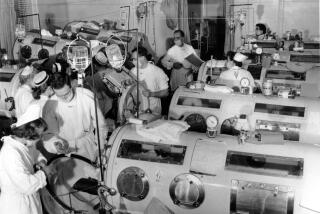Chiron Exploring the Growth Potential in Flu Vaccines
The recent influenza season hit early and hard, and raised the profile of a small biotechnology company in Emeryville, Calif.
Chiron Corp. became the nation’s second-largest producer of flu vaccines last year, thanks to its acquisition of PowderJect Pharmaceuticals of Cambridge, England. The deal added $245 million to Chiron’s revenue in 2003, when it sold its entire flu vaccine inventory -- including 38.4 million doses in the U.S.
And Chiron believes the global flu vaccine market could double to $2.6 billion in the next decade, driven by a federal target of 150 million annual U.S. vaccinations. To meet the demand, the company needs to boost production of vaccine, now grown in chicken eggs.
Chief Executive Howard Pien told analysts last month that Chiron’s vaccine sales should reach $1.3 billion by 2008, exceeding the projected sales of the company’s blood-testing equipment or biotech drugs.
Pien talked with The Times last week about the vaccine business.
Question: There was a severe shortage of vaccine during this past flu season. A year ago, your competitor, Aventis, threw out vaccine it couldn’t sell. What can be done to prevent supply imbalances next flu season?
Answer: It is very difficult to address the supply issue in the short run. In the longer run, it is possible. We are investing $100 million in our flu vaccine business, not just to put up machines and factories but to come up with a more efficient way of making vaccines in chicken eggs.
The next frontier is a new production method called cell culture. It is going to be very important. It may not represent a safety or efficacy advantage over chicken egg-derived vaccine, but it has the potential to reduce the time needed to produce vaccine, allowing manufacturers to respond to spikes in demand.
Q: You currently are testing the cell culture method, which involves growing the vaccine in cells rather than in eggs. If the test is successful, when will you begin using the new production technique? How much production time will it save?
A: The general estimate for a vaccine product is that it takes five to six years to develop it for the market. It is entirely possible we will do this faster, but that is assuming our test is very, very positive. Currently, it takes four months to make flu vaccine in chicken eggs. We believe that time can be reduced by 50%. The net effect will be to increase output.
Q: Chiron made a significant investment last year to enter the flu vaccine business. Yet the business is unpredictable, and its gross profit is low compared with many biotech drugs. Why is the flu vaccine business attractive to you?
A: We believe that the flu vaccine business is growing. After this especially difficult season, public awareness that flu is a serious disease has gone up substantially. We think this makes the 10-year public health objective -- 150 million annual vaccinations -- increasingly realistic. We believe that as the vaccination rate goes up in the U.S. -- the U.S. market is such an important market in terms of size and leadership -- the value of the worldwide flu market will go up as well.
Q: A member of a key congressional subcommittee on health matters has called for hearings on the flu vaccine shortage. If such a hearing takes place, will Chiron offer any testimony on how shortages can be prevented?
A: If we are asked to give an opinion, I think the major tenets of our position will be as follows. First, the disease deserves to be a public health priority. Second, it makes sense to have greater resources put into public education about the disease to reach vaccination targets sooner rather than later. Third, the public interest in this is laudable but should not lead to a government-run manufacturing process. From an R&D; standpoint, the predictability of an investment environment is important. Finally, the interest in flu should be seen in a positive light, which is to say that the disease is addressable, as opposed to going in a direction of demagoguery with one side blaming the other. We haven’t worked out our tenets; I am speaking off the top of my head.
Q: Your acquisition of PowderJect signaled a broad commitment to the vaccine business, a segment abandoned by companies bigger than Chiron. What do you see in vaccines that others don’t?
A: I really can’t speak for the companies that have gotten out. I will say that from Chiron’s perspective, we are a small company and the opportunity we see in vaccines is significant relative to our size. We have a history of scientific innovation and coming up with vaccine products. That gives us insight into new solutions.
Q: But you are not working on vaccines for anthrax, small pox and other biodefense targets. Why are you on the sidelines?
A: The opportunities available to us in vaccines are quite abundant. There is flu and we are involved in vaccines for meningococcal infections. We are one of the last platforms left standing in HIV and we have projects going in hepatitis C vaccines. It is not that we have no worthy targets to go after.
We are quite consciously looking at the field of biodefense and trying to understand it better. It is very early days. We need to understand just how these diseases will shape up and whether or not we have the scientific basis to make a contribution.
Q: Some in the industry have questioned whether the business of developing vaccines for a government stockpile is commercially viable. Does that play a role in your decision?
A: Whether or not one is in a particular scientific area is really a combination of complex forces. One is predictability of demand because these investments are, by definition, long term. Then on the supply side there is the matter of whether or not you can actually do something.
We, for example, know we can do something using the techniques we already have and the scientific platform we already have to come up with a SARS [severe acute respiratory syndrome] vaccine. So, though it is far from clear there is going to be a SARS market, we entered collaboration with NIH [the National Institutes of Health] and came up with a strong vaccine candidate. It just passed the first hurdle -- in animal tests it stood up to challenge with the SARS virus.
So, it is a combination of factors. But it certainly helps to know what the future holds in terms of market dynamics.
Q: What is the next step for your SARS vaccine? When will you be ready to test it in people?
A: There is still quite a bit of work to do in cooperation with NIH. By the end of 2004, we should know whether we have enough data to take it into clinical trials in 2005. We need to do more animal testing and have to figure out how to make the product. That which you test in animals is not necessarily a product you can manufacture.
More to Read
Inside the business of entertainment
The Wide Shot brings you news, analysis and insights on everything from streaming wars to production — and what it all means for the future.
You may occasionally receive promotional content from the Los Angeles Times.










